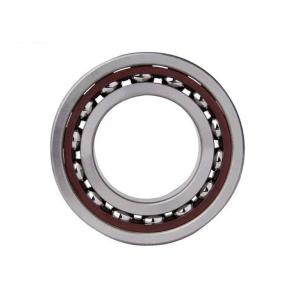| Bore Diameter | 50 mm. This dimension is precisely machined to achieve a tight and
secure fit with shafts. The strict manufacturing tolerances
involved guarantee that the bearing remains firmly in place during
operation, eliminating the risk of slippage or misalignment. This
precise fit is vital for the seamless transfer of rotational motion
and plays a crucial role in preventing premature wear and tear on
both the bearing and the shaft. |
| Outer Diameter | 90 mm. The outer diameter of the 6210 bearing is carefully
calibrated to form a seamless interface with the bearing housing.
This size is optimized to ensure even distribution of loads,
thereby enhancing the bearing's stability and performance within
the mechanical system. A well - proportioned outer diameter
effectively dissipates the forces acting on the bearing,
contributing significantly to its overall durability. |
| Width | 20 mm. The width of the 6210 bearing is designed to strike a
perfect balance between structural integrity and load - handling
capabilities. It is engineered to cope with both radial and axial
loads, which are commonly encountered in a variety of applications.
Whether the forces act perpendicular (radial loads) or along (axial
loads) the axis of rotation, the 20 - mm width of this bearing is
well - equipped to manage these complex loading conditions
efficiently. |
| Bearing Type | As a deep - groove ball bearing, the 6210 boasts a simple yet
highly effective design. The deep - groove profile of its raceways
and the close fit between the balls and the raceways enable it to
handle both radial and axial loads simultaneously. This design also
facilitates smooth rotation, making it suitable for a broad
spectrum of applications where efficient motion transfer is a key
requirement. |
| Cage Material | Typically, the cage of the 6210 bearing is constructed from either
steel or nylon. Steel cages offer exceptional strength and
durability, making them ideal for applications where the bearing is
subjected to high - speed rotations and heavy loads. They
effectively guide the rolling elements (balls), ensuring their even
distribution and smooth movement within the bearing. Nylon cages,
on the other hand, are lightweight and help reduce friction and
noise during operation, which is particularly beneficial in
applications where quiet running is desired. |
| Precision Grade | Commonly available in standard precision grades such as ABEC - 1 or
ABEC - 3. These grades adhere to industry - recognized standards
for dimensional accuracy, roundness, and surface finish. An ABEC -
rated 6210 bearing delivers consistent performance, reduced
vibration, and lower noise levels during operation. This is
especially important in applications where smooth and accurate
motion is critical, such as in precision machinery or high - speed
rotating equipment. |
| Radial Dynamic Load Rating | The 6210 bearing is designed to handle a substantial radial dynamic
load. While the exact value may vary depending on factors such as
the bearing's design, material quality, and manufacturing
standards, it is engineered to withstand significant forces during
continuous operation. This high load - bearing capacity makes it
suitable for applications where the machinery is subjected to
dynamic loads, such as in motors or rotating shafts. |
| Radial Static Load Rating | The radial static load rating of the 6210 bearing is also
impressive. It represents the maximum static radial load that the
bearing can support without undergoing permanent deformation. This
rating is crucial for applications where the bearing may be exposed
to static or slowly varying loads, such as in machinery that
experiences long periods of standby or start - stop operations. |
| Axial Load Capacity | Although the 6210 bearing is primarily designed to handle radial
loads, it also has the ability to accommodate a certain amount of
axial load. This is made possible by its deep - groove design,
which allows the balls to shift slightly and absorb forces acting
along the axis of rotation. While the axial load capacity is
relatively lower compared to its radial load - handling
capabilities, it is still sufficient for many applications where
small axial forces are present. |
| Friction Coefficient | The 6210 bearing is known for its low friction coefficient. The
smooth surface finish of the balls and raceways, combined with the
appropriate selection of lubricants, helps minimize friction during
operation. A low friction coefficient not only reduces energy
consumption but also contributes to maintaining the efficiency of
the mechanical system. It also extends the service life of the
bearing by reducing wear and heat generation. |
| Lubrication Requirements | The 6210 bearing can be lubricated with a variety of lubricants,
depending on the specific application requirements. For general -
purpose applications, grease lubrication is commonly used. Grease
provides long - lasting lubrication and helps protect the bearing
from contaminants. In applications involving high - speed operation
or extreme temperatures, oil lubrication may be preferred. Oil
offers better cooling properties and can handle higher speeds more
effectively. Some 6210 bearings may also come pre - lubricated,
reducing the need for on - site lubrication during installation. |
| Sealing Options | To safeguard the bearing from dust, dirt, and moisture, the 6210
bearing is available with different sealing options. One common
option is the rubber seal, which provides a good level of
protection against contaminants. The rubber seal is typically made
of nitrile rubber or other suitable materials and is designed to
fit tightly around the inner and outer rings of the bearing.
Another option is the metal shield, which offers more robust
protection against larger particles. Sealed bearings are
particularly useful in applications where the operating environment
is harsh or dirty. |










